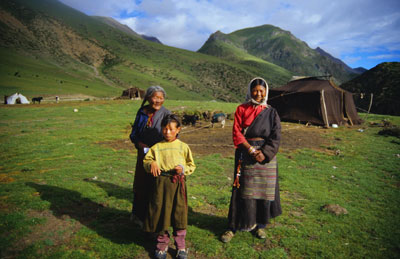Imagine that your hometown has been invaded by a military force that dictates all the resources—the water, the mining, all the natural resources—will be diverted for the exclusive use of the occupying power, and the military. Key resources will be exported back to far-away cities. Rare resources like uranium and lithium. And everything will be conducted in a language you don't understand—the language of the invaders.
Sounds like fiction? It is happening today in Tibet. But not only are Tibet's resources being shifted out, the Tibetan way of life is being snuffed out. Tibetan nomads, who for centuries have been at the heart of the traditional Tibetan economy through herding of yaks and cashmere goats, are being targeted for 're-settlement'. Across the Tibetan plateau, hundreds of thousands of nomads are being shifted off their traditional grassland habitat. 'Re-settlement' is little more than a euphemism for a kind of nomad genocide.
In October 2008, an official report issued in Sichuan Province announced that 470,000 nomads would be resettled, out of a total nomad population estimated at 530,000. The report cited 219,000 nomads as having 'no fixed residences' and 254,000 'living in shanty homes'. In 2004, a document from an official source in Qinghai Province was somewhat blunter—it said that all the nomads of Amdo were to be resettled by the year 2011.
One reason quoted in official Chinese reports justifying the resettlement of nomads is 'inconvenience'—how nomads lead a very harsh life without access to proper education or medical facilities. It is a harsh life, yes—but it is one that the nomads have chosen—a life of great freedom under vast open skies. As for the medical facilities promised: these are very shoddy at best in rural Tibet, with dismal standards, while 'education' amounts to little more than attempts at Chinese indoctrination of Tibetan youth. In fact, there is not much of anything in these villages. It is all window dressing to exclude the nomads from the grasslands.
Where the nomads end up is in a drab village of concrete hovels—a concrete ghetto where there is little chance of making a decent living. In Tibet, being a nomad is not a job you decide upon—it is a job you are born into. These are proud, very tough people who cherish their freedom. They are not used to being beggars, which is basically what they become when they shift to resettlement ghettos—they rely on government hand-outs to survive. There is no attempt at job retraining in these places.
For centuries, Tibetan nomads have worked in harmony with their environment, acting as virtual stewards of the vast grassland regions of Central Tibet, Amdo (northeast) and Kham (southeast). They look after the grasslands because they know they must use these grasslands again. Yet Chinese academic papers talk of putting a halt to grazing to 'restore' the 'degraded' grasslands. Climate change is most likely the real culprit here, but officials are trying to pin the blame the nomads and their yaks for over-grazing, saying this is destroying the grassland habitat. A Western researcher, Julia Klein (from Colorado State University), took issue with this stance, citing the fact that the Tibetan Plateau "is a system that has evolved with grazing: the removal of grazing from the system could have profound ecological consequences."
